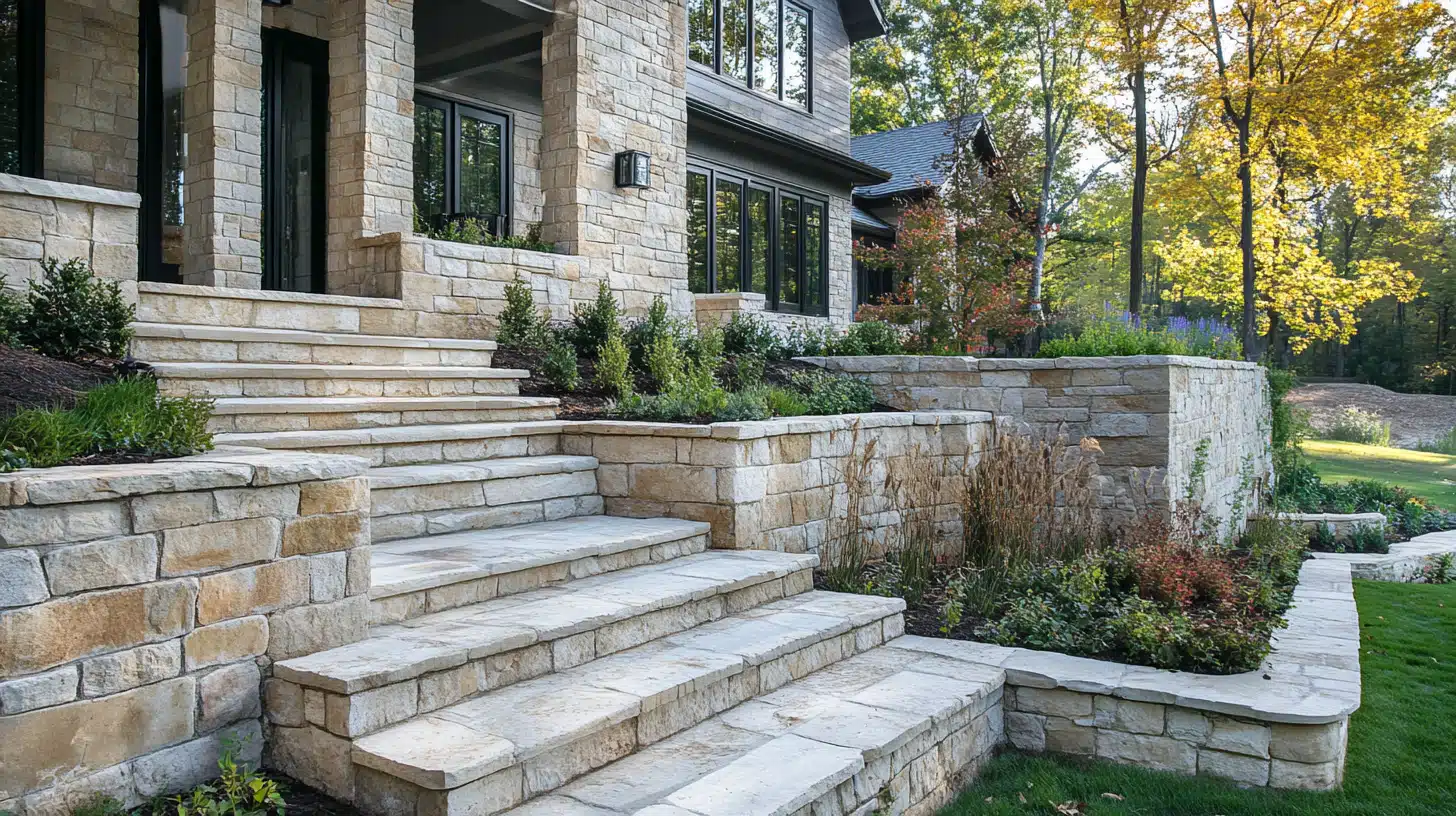Has your stone wall cladding started to look dull and dirty? Exterior stone walls are a beautiful addition to any home, but they require regular maintenance and cleaning to stay in top condition.
In this guide, we will discuss the importance of maintaining your exterior stone wall and share tips on how to keep it clean.
The Importance of Stone Wall Maintenance and Cleaning
Your home’s exterior is constantly exposed to various weather conditions, which can cause dirt, grime, and moss to accumulate on your stone wall.
Additionally, bird droppings, insects, and pollution can lead to dirt buildup and unsightly stains. Over time, exposure to these elements can result in discoloration and deterioration of the stone surface.
Pollutants such as vehicle exhaust can even seep into the stone’s pores, fostering bacterial growth that leads to black stains. These factors can damage the stone and rob it of its natural beauty if left untreated.
Furthermore, failing to perform regular maintenance can lead to more serious issues, such as cracks or structural weakening due to trapped moisture and freeze-thaw cycles.
Regular cleaning of your stone wall cladding helps maintain its appearance and extends its lifespan. Dirt and grime, if not properly removed, can gradually corrode the stone’s surface, potentially resulting in costly repairs or replacements.
Step by Step on How to Clean Stone Wall Cladding
Proper stone maintenance first comes with regular cleaning. This is typically done once or twice a year, preferably in the spring and fall. It is essential to clean your walls before any home improvement, renovations, or repairs.
Step 1: Remove Loose Dirt:
- Brush the stone surface with a soft-bristled brush to get rid of loose debris.
Step 2: Prepare Cleaning Solution:
- For routine cleaning, mix a mild detergent with water.
- For deep cleaning, mix 1-part intensive cleaner (e.g., R155) to 6-parts water. If you can, purchase a pH-Neutral Cleaner as they’re specifically formulated for stone surfaces.
Step 3: Apply and Scrub:
- Use a sponge or soft cloth for routine cleaning, or a stiff natural bristle brush for deep cleaning.
- Scrub the area gently for light dirt or for 3-5 minutes if deeper grime is present.
Step 4: Dwell Time:
- Allow the cleaning solution to sit on the stone for up to 10 minutes (15 minutes for tough stains). Reapply if it starts to dry out.
Step 5: Rinse Thoroughly and Dry:
- Rinse with clean water to remove all residue. Then, let the stone air dry or use a clean, dry cloth to wipe away excess water. If you have persistent stains, repeat the process until the area is clean.
How to Best Maintain Your Stone Walls
Regular cleaning, as discussed earlier, helps to keep your stone wall cladding in top condition. However, maintaining stone walls goes beyond just cleaning. Here are additional maintenance tips to ensure the long-term beauty and durability of your stone cladding:
Step 1: Inspect Your Walls Regularly
- Check for Cracks and Damage: Regularly inspect your stone walls for cracks, loose stones, or any signs of structural damage. This can cause water to infiltrate your walls and potentially weaken the structure.
- Look for Discoloration: Keep an eye out for any discoloration on your stone walls. This could be a sign of mold or mildew growth, which can not only damage the appearance of your walls but also pose health risks.
- Examine Mortar Joints: If your stone wall includes mortar, inspect the joints to ensure they are intact and not crumbling. Repointing the joints when necessary helps maintain the wall’s stability.
Step 2: Control Vegetation Growth
- Limit Climbing Plants: While ivy and other climbing plants might look appealing, they can penetrate and damage the stone over time. Trim back any vegetation to prevent roots from taking hold and causing cracks or dislodgement.
- Clear Organic Debris: Regularly remove leaves, moss, and other debris that can retain moisture and promote decay or staining.
Step 3: Protect Against Excess Moisture
- Ensure Proper Drainage: Make sure the ground around your stone wall slopes away to prevent water from pooling at the base, which can lead to moisture damage and erosion.
- Direct Water Sources: Avoid placing sprinklers or water features near the stone wall to reduce unnecessary exposure to water.
Step 4: Sealing as an Optional Step
Applying a sealant can be beneficial for certain types of stone and situations, but it’s not always necessary. While sealants help repel water and prevent staining, they can sometimes create issues such as trapped moisture and discoloration, especially if applied to dense, non-porous stones.
When to Use Sealants: If your stone is porous (e.g., limestone or sandstone) or exposed to significant water and staining risks, a breathable, water-repellent sealant can provide extra protection.
Potential Setbacks: Keep in mind that sealants can interfere with the stone’s natural ability to breathe, possibly leading to discoloration or cracks if moisture becomes trapped. Consult a professional if you’re unsure whether sealing is appropriate for your stone type.
If you do seal your cladding, opt for a stone sealer specifically designed for the type of stone you have, and follow the manufacturer’s instructions carefully. Be sure to test a small, inconspicuous area first to ensure the desired outcome before sealing the entire wall.
How to Repair Your Stone Wall Cladding
During your regular inspections, if you do notice small cracks and chips, it’s important to address these immediately. The good news is that you’ll just need a stone repair kit, which includes epoxy and resin. Once you have a stone repair kit, follow the instructions below:
Step 1: Assess the Damage
Look for cracks, chips, or loose stones during regular inspections. During this process, ensure to properly identify the extent of the damage. Minor damage will consist of small cracks or chips, while major damage will consist of large cracks or missing stones.
Be cautious of weep holes, which are intentional openings that allow water to drain and prevent moisture buildup. These should not be filled as they are essential for maintaining the wall’s structural integrity.
Step 2: Gather Necessary Materials
- Stone Repair Kit: Includes epoxy resin and color-matching compounds.
- Cleaning Supplies: Soft brush, mild detergent, and water.
- Tools: Putty knife, applicator, and protective gloves.
Step 3: Clean the Damaged Area
Use a soft brush to eliminate loose dirt and debris. Once you have a smooth surface, clean with mild detergent and water; ensure the area is thoroughly dry before proceeding.
Step 4: Prepare the Repair Compound
Follow the stone repair kit instructions to blend the epoxy resin and color-matching materials. Then, ensure the mixture matches the stone’s color and texture.
Step 5: Apply the Repair Compound
Use a putty knife to apply the mixture into cracks or chips, slightly overfilling to allow for settling. Afterwards, level the compound with the surrounding stone using the applicator.
Step 6: Allow the Repair to Cure:
Let the repair be set as per the manufacturer’s guidelines, typically 24-48 hours. During this time, keep the repaired section dry and undisturbed during curing.
Inspect the Repair:
After curing, ensure the repair blends seamlessly with the existing stone. However, if imperfections do remain, repeat the process for a better finish.
Additional Tips:
- Stain Removal: For tough stains or streaks, consider using an acid wash (e.g., diluted muriatic acid) with proper safety gear. Apply cautiously, wet the surface beforehand, and rinse thoroughly.
- Pressure Washing: For light cleaning, a low-power pressure washer can help, but avoid high pressure to prevent damage to the stone or mortar.
Note: For significant damage, such as large cracks or missing stones, it’s advisable to consult a professional. Replacing stones can be complex and may require specialized skills to maintain the wall’s integrity and appearance.
Regular maintenance and prompt repairs will help preserve the beauty and durability of your stone wall cladding.
Conclusion
Stone wall cladding adds a timeless touch to any building or landscape. With proper care and maintenance, it can last for decades and even centuries. Regularly inspecting for damage and addressing it promptly ensures the longevity of your stone wall’s structure and aesthetics. Remember to use appropriate safety gear and materials when handling repairs, and consult a professional for more extensive damage.
Enjoy the beauty of your stone walls knowing that you are taking good care of them. Happy cladding! So whether you have an existing stone wall or are planning to install one, keep these tips in mind to maintain its natural beauty and strength for years to come. Good luck with your stone wall maintenance journey!








